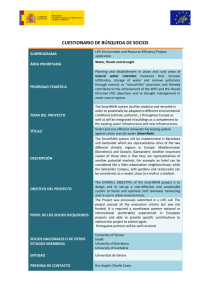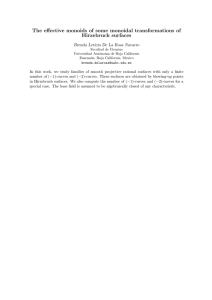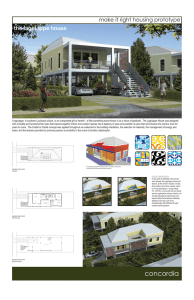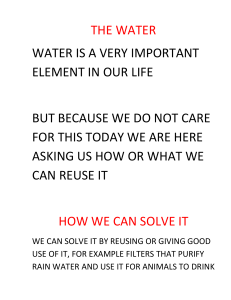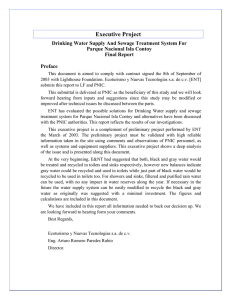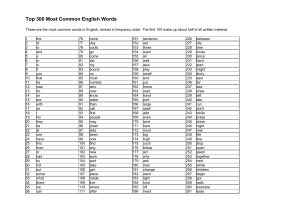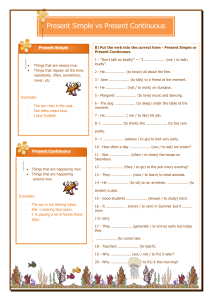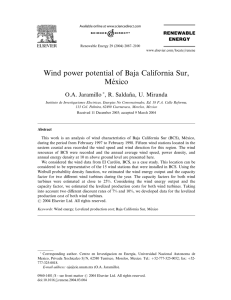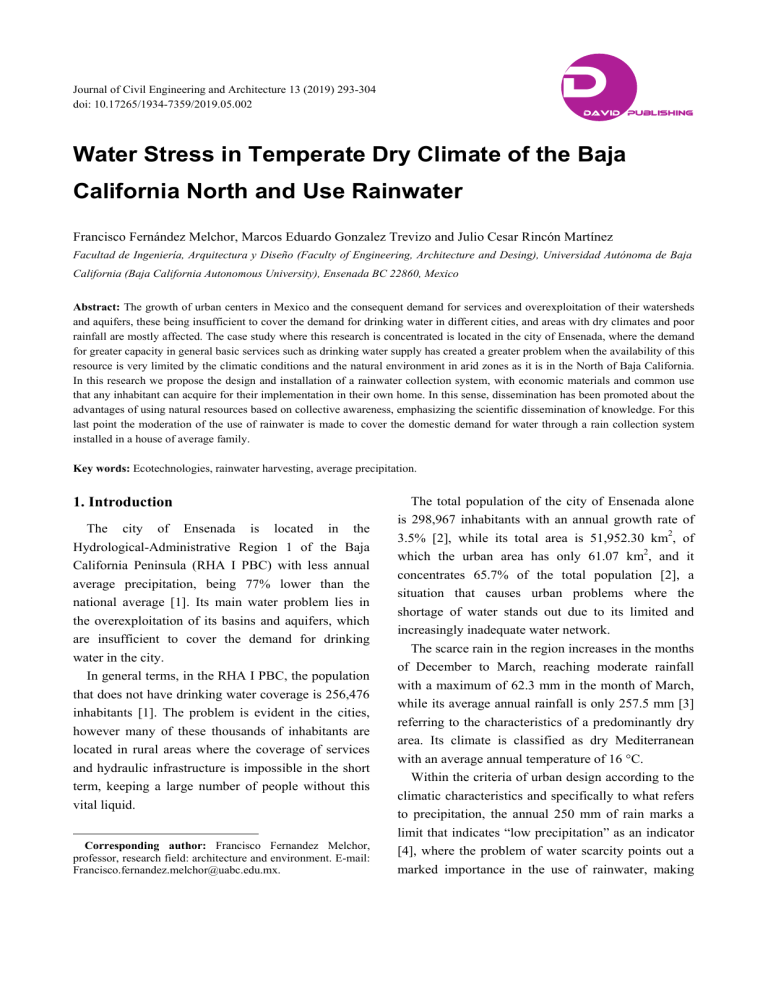
D Journal of Civil Engineering and Architecture 13 (2019) 293-304 doi: 10.17265/1934-7359/2019.05.002 DAVID PUBLISHING Water Stress in Temperate Dry Climate of the Baja California North and Use Rainwater Francisco Fernández Melchor, Marcos Eduardo Gonzalez Trevizo and Julio Cesar Rincón Martínez Facultad de Ingeniería, Arquitectura y Diseño (Faculty of Engineering, Architecture and Desing), Universidad Autónoma de Baja California (Baja California Autonomous University), Ensenada BC 22860, Mexico Abstract: The growth of urban centers in Mexico and the consequent demand for services and overexploitation of their watersheds and aquifers, these being insufficient to cover the demand for drinking water in different cities, and areas with dry climates and poor rainfall are mostly affected. The case study where this research is concentrated is located in the city of Ensenada, where the demand for greater capacity in general basic services such as drinking water supply has created a greater problem when the availability of this resource is very limited by the climatic conditions and the natural environment in arid zones as it is in the North of Baja California. In this research we propose the design and installation of a rainwater collection system, with economic materials and common use that any inhabitant can acquire for their implementation in their own home. In this sense, dissemination has been promoted about the advantages of using natural resources based on collective awareness, emphasizing the scientific dissemination of knowledge. For this last point the moderation of the use of rainwater is made to cover the domestic demand for water through a rain collection system installed in a house of average family. Key words: Ecotechnologies, rainwater harvesting, average precipitation. 1. Introduction The city of Ensenada is located in the Hydrological-Administrative Region 1 of the Baja California Peninsula (RHA I PBC) with less annual average precipitation, being 77% lower than the national average [1]. Its main water problem lies in the overexploitation of its basins and aquifers, which are insufficient to cover the demand for drinking water in the city. In general terms, in the RHA I PBC, the population that does not have drinking water coverage is 256,476 inhabitants [1]. The problem is evident in the cities, however many of these thousands of inhabitants are located in rural areas where the coverage of services and hydraulic infrastructure is impossible in the short term, keeping a large number of people without this vital liquid. Corresponding author: Francisco Fernandez Melchor, professor, research field: architecture and environment. E-mail: [email protected]. The total population of the city of Ensenada alone is 298,967 inhabitants with an annual growth rate of 3.5% [2], while its total area is 51,952.30 km2, of which the urban area has only 61.07 km2, and it concentrates 65.7% of the total population [2], a situation that causes urban problems where the shortage of water stands out due to its limited and increasingly inadequate water network. The scarce rain in the region increases in the months of December to March, reaching moderate rainfall with a maximum of 62.3 mm in the month of March, while its average annual rainfall is only 257.5 mm [3] referring to the characteristics of a predominantly dry area. Its climate is classified as dry Mediterranean with an average annual temperature of 16 °C. Within the criteria of urban design according to the climatic characteristics and specifically to what refers to precipitation, the annual 250 mm of rain marks a limit that indicates “low precipitation” as an indicator [4], where the problem of water scarcity points out a marked importance in the use of rainwater, making 294 Water Stress in Temperate Dry Climate of the Baja California North and Use Rainwater adaptations to the design that mainly promote rainwater harvesting. Despite the characteristic dry climate and the problem of water supply, the population that makes up the city of Ensenada does not show a concern, nor awareness of the importance that lies in the use of limited water resources as it would be the collection of rainwater through simple home systems of rainwater harvesting [5]. On the contrary, the problem falls on the State Commission of Public Services of Ensenada (CESPE) indicating it as a commission that does not provide an efficient service. Fig. 1 The phenomenon of meteorological drought. 2. Method and Materials 2.1 Regional Characteristics The climate of the Baja California Peninsula is generally dry and warm, with temperate parts in the northern subregion (where Ensenada is located) and in the mountain areas. To this climate with little precipitation is added the phenomenon of meteorological drought [6] occurs when there is a significant decrease in precipitation with respect to the annual average and that lasts several months or years as in Fig. 1. Water Stress in Temperate Dry Climate of the Baja California North and Use Rainwater The main effects of this phenomenon are in agriculture and livestock, with serious socio-economic consequences for the rural and urban population. This phenomenon can bring multiple repercussions that go from the deterioration of agricultural production, the loss of crops and the scarcity of food; reduction of industrial activity, which affects the generation of few jobs; deterioration of public health, caused by the poor hygiene, famine and mortality of the population, particularly children and the elderly; generation of massive migrations from the rural area to the cities in search of food and work, which in turn generates an oversupply of resources in the cities, which transforms into unemployment, crime and insecurity. According to reports from the Public Registry of Water Rights (REPDA) the main use of water in Baja California is in the agricultural sector with 80% of the volume concession, followed by public-urban and domestic supply with 12%, the use for thermoelectric plants 5%, industrial use with 2% and other uses 1%, as in Fig. 2. This research focuses on the second place that includes domestic use, which is very important because of the number of inhabitants of the city. If to the city of Ensenada, neighboring towns Fig. 2 The main use of water in Baja California. 295 belonging to the municipality are added, the number of inhabitants increases to 486,639 inhabitants, of which 49.8% are men and 50.2 are women. For this reason the region is limited in its supply of surface and underground water, mainly due to the high consumption of water for irrigation and the waste of domestic, urban and commercial water, as well as water losses in the municipal hydraulic system. In addition, there is a lack of infrastructure to take advantage of the water from streams and rivers, as well as rainwater; and there is no water culture in the region, as well as a lack of environmental education. To meet the demand for water it has been required to extract large volumes of aquifers, which has caused a serious problem of overexploitation and groundwater contamination; which is presented in eight of the aquifers of the so-called “Zona Costa”, where the agricultural valleys of Maneadero, Camalú, Ojos Negros, Valle de la Trinidad, Valle de Guadalupe, Colonia Vicente Guerrero, Ensenada and San Quintín are located as in Fig. 3. According to indicators of the last census at the state level, the coverage of rural drinking water amounted to 72.9% and the urban coverage to 95.1%. While in the case of Ensenada the coverage of drinking 296 Water Stress in Temperate Dry Climate of the Baja California North and Use Rainwater Fig. 3 Aquifer problems. Fig. 4 Coverage of drinking water. Water Stress in Temperate Dry Climate of the Baja California North and Use Rainwater water in the rural area exceeds by very little 60% and the urban almost covers 100% (Fig. 4). The dispersion of the population in rural areas causes technical difficulties for the supply and operation of drinking water, sewage and sanitation services, so their coverage is lower than in the urban area. For this reason in this research, the alternative of using rainwater that could contribute to water supply in rural areas is studied. The current growth of Ensenada and the demand for housing, according to the population census indicate that there are 143,169 private homes inhabited by 481,431 occupants, of which 92.87% are houses; 2.86% apartment in buildings; 2.18% neighborhood; 1.43% other type of housing and 0.66% are not specified. The characteristics and typology of the houses are of marked relevance since it depends on the viability of the use of rainwater through roofs. Of this total of homes in Ensenada, 7.25% have a room; 17.64% two rooms; 23.29% three rooms; 23.94% four rooms; 15.17% five rooms; 12.66% six or more rooms and 0.04% are not specified. With these data it can be seen that the highest percentage of homes in the municipality has three and four rooms, which account for the roof area, where rainwater would be captured. The materials used in the construction of the walls in the houses are 0.19% cardboard and waste materials; 0.97% earth, sheet or palm; 17.75% wood or adobe; 80.94% partition, brick, block, stone, cement or concrete; and 0.14% are not specified. While the materials in cover are 0.33% cardboard and scrap materials; 58.41% metal sheet or asbestos, palm or straw; 0.29% wooden beams and roof; 40.72% concrete slab or joist with vault; and 0.25% are not specified. Taking into account the prevalence of house in the city ranging from one to two floors, the dimensions of this according to the spaces that compose it, as well as the materials that constructively constitute walls and roofs, they allow us to conclude that the addition of a 297 rainwater collector can be useful to cover part of the demand for drinking water by the occupants of these homes. These homes for their availability and access to water according to INEGI data of the total of these 481,431 houses, 91.89% has piped water and 8.09% of the remaining water is obtained by hauling of which 1.44% is through a community outlet and 7.99% comes from somewhere else. Of this total, which corresponds to water per carry, 86.75% comes from a pipe; 2.30% of a well; 0.33% of rivers or lakes; while the collection of rainwater in Ensenada is not used at all. 2.2 General Purpose Design, characterization and implementation of a pluvial water collection system adapted to the configuration of a social interest property characteristic of the city of Ensenada for the measure of its contribution to the necessary supply of water demand in the common activities of a home. After a representative period of time of measurement, said pluvial system and the results obtained, it is proposed that these serve to be presented in talks, conferences and meetings where its main audience is young people and children; in order to create an awareness of the importance of taking advantage of the limited water resources of the city. 2.3 Specific Objectives The specific objectives that make up the research project on water stress, and rainwater harvesting are the following: Choice of a representative dwelling of the city of Ensenada from a statistical study that determines the characteristics and specific dimensions of this. Survey and description of the house, hydraulic characteristics and calculation of the demand for drinking water. Measurement of the rainfall regime in representative periods of the year through equipment Water Stress in Temperate Dry Climate of the Baja California North and Use Rainwater 298 and physical instruments and by processing standardized climate data. Design and characterization of a drinking water collection system adapted based on the formal architectural attributes of the home and its adequate sizing for the collection based on rainfall analysis. Measurement of the contribution and water supply of the rainwater collection system accompanied by a comparative study with the regular demand of the potable water service in a house. Processing of data and preparation of material for dissemination (presentations, congress and posters). 2.4 Goals The goals represent the completion and fulfillment of the specific objectives set out in the research project: Attend to the problem of water stress in the most disadvantaged society, offering a self-built practical solution. Involve students of the educational program of Architecture Universidad Autónoma de Baja California (UABC) Ensenada in the design and characterization of a rainwater collection system. Presentation of the data obtained from the performance of the model carried out and the constructive theoretical methodology used. Fig. 5 House in Vista Hermosa colony. Through scientific dissemination, inform and raise awareness in society about the benefits of the use of resources, as well as the collection of rainwater. Realization of the pluvial water collection system model with materials commonly used in construction and recycling, developing a simple manual of viable construction and applicable to any economy. 2.5 Design Variables For this research we have a social interest housing (Casas Geo BC) located in Calle Hierro No. 214, Vista Hermosa colony. Dimensions of the property: 115 m2 (20 × 5.77 m). Construction: 55 m2. Description: 2 bedrooms, 1 bathroom, living room, kitchen, garage and service patio (Fig. 5). The first point is to determine the amount of rainfall, which is defined as the hydrometeor that falls from the sky and reaches the earth’s surface in the form of rain, drizzle, snow, haze or hail, and is measured in mm, whose equivalence is placed on a flat and impermeable surface of 1 m2 and the quantity in liters of the thickness of precipitated water [7]. The supply of rainwater is defined by the average monthly amount of rainwater or annual in mm per m2. These data will be obtained from the climatological normals of the National Meteorological System. Water Stress in Temperate Dry Climate of the Baja California North and Use Rainwater The demand for rainwater is the amount of rainfall needed for a family to cover their needs for cleaning patios, washing floors, watering gardens, flushing toilets, etc. This amount of water will be calculated according to: Number of users (on average the family in the city of Ensenada is composed of 3.6 people [9]. Number of days of the month endowment (L/person-day) (150 L were considered in the calculation). 2.6 Calculation Model The calculation model starts with a list of consumption liters per piece of furniture and per activity that requires water supply as shown in Table 1. The consumption per piece of furniture is multiplied by the number of occupants of the house (3.6 persons) and this result in turn by the number of days of each month to obtain the monthly consumption. A differentiation is made between non-substitutable drinking water such as shower, dishwashing, personal Table 1 Table 2 hygiene, cooking and drinking; and the replaceable rainwater as the toilet tank, garden irrigation, cleaning and car washing. Once the consumption is determined, it is important to count the cover area that will serve to capture the rainwater that in the case studied is 45.73 m2. The standardized data of rainfall must be included in the calculation model to determine the amount of water that can be obtained by abstraction in the roof area, this normalized data averages 10-year minimum monthly data are presented in Table 2 and correspond to the meteorological station of SMN located in the air base of the city of Ensenada. With this information, both of consumption, as of occupants, as well as of the normal data of average monthly precipitation; we can estimate the total water demand for the house using an equation [7] that is presented as Eq. (1): Di = Nu × Nd × Dot/1,000 (1) 3 Di: monthly demand (m ); Nu: number of users or people; Nd: number of days of the month analyzed. Water consumption lts/person/day. Restroom sink Toilet Watering can Sink Washed Cleaning 25 L 20 L 32 L 18 L 40 L 12 L Average monthly precipitation. Month January February March April May June July August September October November December 299 Rain (mm) 24 65 26 14 4 3 5 3 5 20 26 25 300 Water Stress in Temperate Dry Climate of the Baja California North and Use Rainwater 2.7 Development of the Model The main components of the model implemented, as in Fig. 6, as rainwater collection system [8] are the following: (1) The rooftop; (2) The gutters and downpipe; (3) Sheet filter; (4) Water tank. (1) The roof. It is recommended not to have pets, plants or to use it in any other way. The roof should be washed before the rainy seasons and during these, striving to sweep thoroughly to ensure cleanliness of Fig. 6 Components of rainwater collection system. Fig.7 The roof and gutter. the collected water. In this case, a row of bricks were placed on the edges of the roof to carry the water over a single drop of water on which a gutter was placed, as in Fig. 7. (2) Gutter and downspout. These lead the collected rainwater to the container tank. It is advisable to keep the gutter and drainpipe clean and treeless, as in Fig. 8. (3) Sheet filter. This is usually a mesh that prevents the fall of leaves or garbage to the deposit. (4) Water tank. This intercepts the first rains. In this investigation, the deposit is 200 L and in this the amount of rainwater use was made, and the system was finished up to this point, as in Fig. 9. In the case Water Stress in Temperate Dry Climate of the Baja California North and Use Rainwater Fig. 8 Gutter and downspout. Fig. 9 Water tank. 301 Water Stress in Temperate Dry Climate of the Baja California North and Use Rainwater 302 of having a cistern of rainwater, this deposit serves to separate the dirt from the rains and send it clean to the cistern [9]. 3. Results and Discussions The calculation of monthly consumption shows an approximate figure of 15,876 liters if a month is contemplated with 30 days, this amount of drinking water being the amount needed to cover the needs of a house with 3.4 occupants. This total in liters represents 100% of the demand for this vital liquid. The roof area of 45.73 m2 depending on the amount of monthly rainfall could get a certain amount of water to be used in the home. If we observe the month with the most amount of rain, which is February with a precipitation of 65 mm, it is possible to obtain up to 2,972.45 liters which would represent 76.29% of the total water substitutable by rainwater and that the house would use for flushing the toilet, cleaning of patios and irrigation of gardens among others. In the case of dry months with very little or no rain, as it is from May to September, the rainwater collection and utilization system would have a low performance of 42% of the substitutable water, obtaining rain or fog as shown in Table 3. The city of Ensenada has a temperate dry climate, reason why the rain in this region is scarce; if the water intake is compared with the total monthly Table 3 demand, rainwater represents a low percentage. In the case of the month with more rain, the use of this only represents 19.82% of the total demand; while the month with less rain could only provide 0.91% of the total water demand. After the analysis of the calculated rainwater collection, the amount of rain was measured with a rainfall meter installed in a meteorological station, as in Fig. 10. The months with the highest record were chosen in terms of the amount of rain, the months analyzed were February and March, as shown in Table 4. It should be noted that these months of 2018 had a lower amount of rain than that obtained from normal data. The month of February 2018 was four days with rain, on the 27th of that month, the day with the most rain. The full month had 20.4 mm of precipitation according to the record of the weather station. On the other hand, the month of March presented seven days with rain where in some cases it was only for less than an hour, whose day with the highest rainfall was on March 10, accumulating only 7.6 mm of rain throughout the month. The results obtained from this research project will be mainly in determining the performance of a rainwater collection system and in measuring the amount of water that can contribute to the needs of a household and on the variables that can occur in both Collected rainwater calculated. Month January February March April May June July August September October November December Collected rainwater 1,097.52 L 2,972.45 L 1,188.98 L 640.22 L 182.92 L 137.19 L 228.65 L 137.19 L 228.65 L 914.60 L 1,188.98 L 1,143.25 L Water substitutable (%) 63.78% 76.29% 64.39% 60.73% 57.68% 57.38% 57.99% 57.38% 57.99% 62.56% 64.39% 64.09% Total demand (%) 7.32% 19.82% 7.93% 4.27% 1.22% 0.91% 1.52% 0.91% 1.52% 6.10% 7.93% 7.62% Water Stress in Temperate Dry Climate of the Baja California North and Use Rainwater Fig. 10 Table 4 Weather station. Collected rainwater measure. Month February March Fig. 11 303 Collected rainwater 932.89 L 347.55 L Water substitutable (%) 62.68% 58.78% Total demand (%) 6.22% 2.32% Technical sheet. the amount of rain throughout the year, as well as the number of occupants of the house and its demand for water [10]. The construction process, as well as the design and characterization of the collection system will help the development of an assembly manual, as in Fig. 11; technical sheet of elements and materials that compose it for its dissemination and that this can be implemented in the most disadvantaged homes by the shortage of drinking water in Ensenada. 304 Water Stress in Temperate Dry Climate of the Baja California North and Use Rainwater The design, development and dissemination of the water that falls to the public subminister, it is essential system will serve for a campaign of awareness and the to have savings and use plan when this important importance of the use of natural resources with resource is scarce, expensive and intermittent emphasis on the problem of water scarcity. occasions. 4. Conclusion References In a house in which 150 liters of drinking water per day per person is consumed, the total consumption can be replaced by rainwater by up to 50% when storing it. Rainwater can be used in flushing toilets, watering green areas, cleaning patios, washing cars. The impulse of the integration of eco technologies to cover the demand of new popular housing has been scarce in Mexico, where the Institute of the National Fund of Housing for Workers (INFONAVIT), as a government agency, has promoted in its Green Mortgage in terms of saving water, only valves economizing in showers, sinks and sinks but not some system of rainwater use. The effectiveness of this type of eco technologies lies also in the awareness and rational use of water. The cultural and educational aspect focuses on leaving behind the traditional housing schemes where rainwater is not used but also contaminated and wasted when it is led through gutters that are connected in turn to sewers that eventually end up in the drainage, where the rainwater is mixed with black, soapy and residual water, completely contaminating the rainwater. The current growth of the cities as is the case of Ensenada and the increase in the demand for drinking [1] CONAGUA. 2012. Programa Hídrico Regional Visión 2030. Región Hidrológico-Administrativa I Península de Baja California. Consultado el 25 de Septiembre de 2016. http://www.conagua.gob.mx/conagua07/publicaciones/pu blicaciones/1-sgp-17-12pbc.pdf. [2] CONAPO. 2016. Base de Datos—Consejo Nacional de Población. http://www.conapo.gob.mx/work/models/CO NAPO/indices_margina/.../CuadrosAnexoB_VF.xlsx. [3] SMN-CONAGUA (s.f.). Normales Climatológicas del periodo 1951-2010, Observatorio Sinóptico de Ensenada, Servicio Meteorológico Nacional, Comisión Nacional del Agua, Ensenada, B.C. [4] Bazant, J. 1984. Manual de Criterios de Diseño Urbanos. 2a Edición, México: Editorial Trillas. 1. [5] Organización de las Naciones Unidas para la Agricultura y la Alimentación. 2000. Manual de captación y aprovechamiento del agua de lluvia, experiencias en Latinoamérica. Chile: Oficina regional de la FAO para América latina y el Caribe. [6] Organización de las Naciones Unidas para la Agricultura y la Alimentación. 2013. Captación y almacenamiento de agua de lluvia. Chile: Oficina regional de la FAO para América latina y el Caribe. [7] UNATSABAR. 2001. Guía de diseño para captación del agua pluvial. Lima: OMS [8] García, J. 2012. Sistema de captación y aprovechamiento pluvial para un ecobarrio de la Cd. de México. México: UNAM. [9] Anaya, M. 1998. Sistemas de captación de agua de lluvia para uso doméstico en América latina y el Caribe. México: IICA. [10] Impluvium. 2014. Sistemas de captación de agua de lluvia. México: UNAM.
